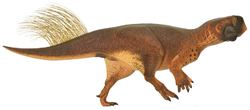| Ojoceratops Temporal range: Late Cretaceous, | |
|---|---|
 | |
| Speculative life restoration | |
| Scientific classification | |
| Kingdom: | Animalia |
| Phylum: | Chordata |
| Class: | Reptilia |
| Clade: | Dinosauria |
| Clade: | † Ornithischia |
| Clade: | † Ceratopsia |
| Family: | † Ceratopsidae |
| Subfamily: | † Chasmosaurinae |
| Tribe: | † Triceratopsini |
| Genus: | † Ojoceratops Sullivan & Lucas, 2010 |
| Type species | |
| †Ojoceratops fowleri Sullivan & Lucas, 2010 | |
Ojoceratops ( meaning "Ojo Alamo horned face") is a genus of ceratopsian dinosaur which lived in what is now New Mexico, United States. Ojoceratops fossils have been recovered from strata of the Ojo Alamo Formation (Naashoibito Member), dating to the late Cretaceous period (late Maastrichtian age, 66 and 68 million years ago [1] ). The type species is Ojoceratops fowleri.




